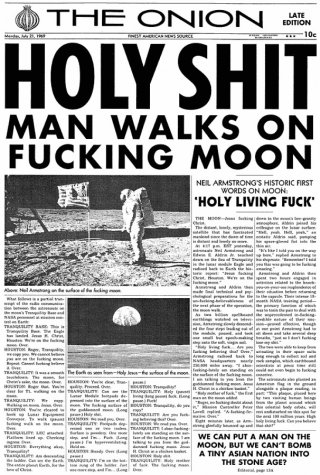A while ago, I ran accross this McSweeney’s article that pit Alien vs. Predator in a series of unlikely events like Macramé and Lincoln-Douglas Debating. Long time readers will know that I am a fan of the Alien vs. Predator concept, though the recent films have been awful (Alien, Aliens, and Predator are some of my favorites movies though, and the original AvP comic book was fantastic). In any case, I couldn’t resist discussing and debating some of the events listed out, and the result was a pretty amusing (and incredibly geeky) conversation.
The first event under question was Breakdancing. I had picked the Alien for this and thought it was the obvious choice. My friend Roy disagreed, noting:
I think you’ve failed to take into account the unique physiology of the alien. Those tubes on his back? The tail? Those are going to make dancing very difficult. No backspins for him. I think that the Predator’s upper body strength will help him to pull of some awesome moves. And, he doesn’t have big pipes or tubes coming up out of his back.
I have to admit that he had a point about the tubes on the Alien’s back, but I still felt the Alien was the superior breakdancer. My response:
Point taken, but I still see the Alien having much more agility, thus giving them the ability to move more gracefully than the Predator while break dancing. While their backspins might be problematic, they do have that giant head which would enable them to perform some rather spectacular headstands and headspins. And while the tail could get in the way of a back-spin, it would also give them a valuable 5th pivot with which they could pull off all sorts of crazy moves. Back spins are an important part of break dancing, but there are no shortages of upper body, frontal, side, or sliding moves, and indeed, there seem to be more of those than back maneuvers. When you add in the Alien’s unique physiology, you get something that would allow for all sorts of variations and indeed, even totally new moves. Really, I think the Alien would revolutionize the break dancing scene. The predator’s upper-body streght would allow for some amazing handstand style moves, but in almost every other way they are less limber and agile than the alien or even most human break-dance experts. Indeed, the alien does not seem to have an absense of upper body strength, so it’s not like that gives the Predator a decisive advantage (the way the alien’s tail does). I suppose it’s possible that not all Predators are as bulked up as the ones in the films, but there is no real evidence of that.
Personally, I still believe I’m right on that one. The next event that came into question was Competitive Hot-Dog Eating. My initial pick was Predator, mostly because of his larger mouth and mandibles (when you look closely, the Alien’s mouth is actually quite small). Anyway, Roy had some comments about this pick as well:
Totally goes to alien. Aliens are always hungry. They do nothing but eat and kill. We don’t even actually know that Predator’s eat meat. They’re probably a bunch of annoying vegans. ;P
Once again, I think Roy makes a fair point here, but it’s ultimately unpersuasive. My response:
This makes more sense to me, though I do maintain that the Alien’s multi-tiered mouth is still significantly smaller and thus represents a bottleneck during any sort of competitive eating contest. Yes, their activities are generally limited to eating, killing, building those crazy hives and reproducing, but I see that as just a further example of why they would not be good at competitive eating. Since that’s all they do, they do not have to eat fast. It’s hard to tell because the alien and it’s motivations are so… alien… and unexplored. The Predators, on the other hand, clearly have some sort of civilization with technological capabilities well beyond our own. It stands to reason that they would have less time dedicated to eating, and thus would need to scarf down more in less time… which means they would be better suited towards competitive eating. Your point about vegan Predators is also taken, but what we know of their culture is that it is based primarily on hunting. While I’m sure there are vegan Predators, I think it’s fair to speculate that a race of hunters values and prizes meat.
I thought that was pretty good, but someone else stepped in at this point to defend Roy, noting that:
We know they hunt, yes, but in the hunts we’ve seen they take trophies, not food. I have yet to see a predator field-dress an alien. I mean, hell, how much meat could be on something like that anyway? It’s all chitin and sinew, not really a meal at all, and that’s before we think about the effects upon the stomach lining of that acid blood (ulcers like you wouldn’t believe!!). No, it’s not fair to speculate on their eating habits by looking at their hunts. Their hunts are trophy kills, rites of passage, not a means for survival. Everything we’ve seen of their society, we haven’t been given clue one about their eating habits.
This is certainly an interesting take on the matter. My response:
Interesting point, but I think it’s reasonable to make some extrapolations based on their hunting culture. It’s reasonable to assume that their hunts as portrayed in the movies are indeed trophy hunts and not a matter of survival or food. This makes sense on an additional level because they’re hunting alien species and alien physiology may not react well with their digestive systems (as you mention, the alien would be particularly bad in that respect). However, it’s also reasonable to assume that the reason for their hunting tradition is that they were required to do so in the evolution of their species. Yes, I’m extrapolating from human experiences here, but there are humans today who hunt purely for trophies. It’s reasonable to assume that the reason the Predator race is so focused on hunting is that they were forced to do so on their home planet. Indeed, in such a case, the act of hunting could take on a more meaningful aspect because of symbolic or perhaps even spiritual reasons. The act of hunting clearly goes beyond survival for them, but it’s reasonable to assume that it began as a simple survival technique on their home planet, and grew into a more meaningful practice as the race became more advanced.
This thread went on for a few more posts and ultimately resulted in a stalemate, as we really don’t know enough about either culture to say for sure. I still think it’s reasonable to say that the hunting culture of the Predators implies a history of hunting and meat-eating.
The next topic under debate was the Wet T-Shirt Contest, which I had originally given a tie. After all, for the most part, we see both the Alien and the Predator without their shirts on, so what’s the point of a Wet T-Shirt Contest? However, someone interjected a brilliant point that totally convinced me that I was wrong; the Alien would undoubtedly win this event.
Wet T-shirt: Alien. Preddy has been noted on several occasions to be “one ugly motherfucker.”
There is simply no arguing with that one.




